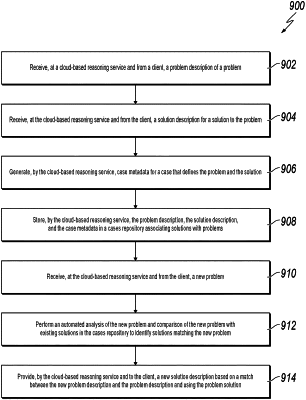| CPC G06N 5/04 (2013.01) [G06N 20/00 (2019.01)] | 17 Claims |

|
1. A computer-implemented method comprising:
receiving, at a case-based reasoning service and from a client, a problem description of a problem;
receiving, at the case-based reasoning service and from the client, a solution description for a solution to the problem;
generating, by the case-based reasoning service, case metadata for a case that defines the problem and the solution;
storing, by the case-based reasoning service, the problem description, the solution description, and the case metadata in a cases repository associating solutions with problems;
receiving, at the case-based reasoning service and from the client, a new problem;
performing an automated analysis of the new problem and a comparison of the new problem with existing solutions in the cases repository to identify solutions matching the new problem;
providing, by the case-based reasoning service and to the client, a new solution description based on a match between the new problem description and the problem description and using the problem solution;
receiving, at the case-based reasoning service and from the client, feedback associated with the new solution description;
updating, by the case-based reasoning service and using the feedback, statistics about that new solution description;
determining, by the case-based reasoning service and using the feedback, whether the new solution description is an exact solution to the problem; and
when the new solution description is not an exact solution to the problem:
determining, by the case-based reasoning service, that a duplicate solution is needed;
determining, by the case-based reasoning service and using the feedback, the duplicate solution;
providing, by the case-based reasoning service and to the client, a new solution description of the duplicate solution; and
updating, by the case-based reasoning service, the cases repository to include the new solution description.
|